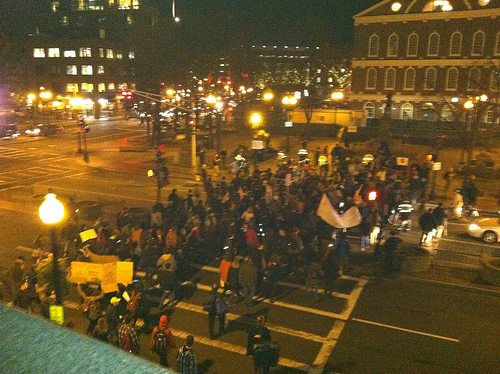August 7, 2012; Source: Yes!
Every now and then, the NPQ Newswire takes a look at some of the reverberations from the Occupy movement, which seems to have largely faded from vision with the police evictions of most of Occupy’s various encampments around the nation. For all of Occupy’s sturm und drang during its heyday, is there anything left from the movement?
The publisher of one of the dozen or so books that emanated from Occupy encampments (This Changes Everything), Yes! magazine continues to be a regular source of opinion and insights about what things Occupy might have actually changed. The web editor of Yes!, James Trimarco, has been a regular writer about the Occupy movement and offers five lessons or insights—five “good ideas”—that he gathered from the Occupy national gathering in Philadelphia (#natgat), which NPQ looked at recently (see here and here). Hear are Trimarco’s findings:
-
The reformatting of the General Assemblies: Trimarco writes that “it’s crucial that there be a regularly scheduled meeting place where people can get together, bring proposals, discuss them, and then develop a plan of action.” The good idea, he says, is to allow for change in the General Assemblies structure and process. The suggestions he identified included “open mic” times or, modeled on something suggested by a representative of the Yippie Museum, a “People’s Soapbox.” However, it’s not all that clear that these suggestions would overcome the criticisms that the Assemblies were loaded with process, hard to govern, difficult to channel toward decisions, and easily hijacked by whoever might show up with an agenda, even if they hadn’t participated much or at all before then.
Sign up for our free newsletters
Subscribe to NPQ's newsletters to have our top stories delivered directly to your inbox.
By signing up, you agree to our privacy policy and terms of use, and to receive messages from NPQ and our partners.
-
The inclusion of marginalized voices: Trimarco notes that “larger meetings at Natgat were filled with the voices of those who said they still felt marginalized in the movement,” particularly women dictated to by men, people of color dictated to by whites, and “radicals…tired of feeling lectured to, or even ‘policed’, by more moderate types.” The “good idea” is a “Step Back! Step Up!” policy that asks people who speak a lot to “wait until the end of the stack before speaking…And that goes double if you happen to be white and male.”
-
The discussion of dealing with police: It seems that the Occupiers have been evolving in their dealings with the police, becoming increasingly concerned with “avoiding some of the violence that has marred” some Occupy marches and events. The new strategy is “separation of time and space,” which Trimarco says is “activistese for planning separate marches for different levels of involvement, each coded with its own color. Those who are unable or unwilling to be arrested can go to the Green march, for example, while those prepared for arrest may join a Red march.”
-
The need for emotional support: It seems that the idea here is to allow for “safe spaces” within which Occupiers can debrief with confidence and support.
-
The importance of encampments: While most Occupy encampments are things of the past, a few still continue, according to Trimarco, including the longest-running encampment in Fresno, Calif. Are these physical manifestations of the Occupy movement necessary to its identity and impact? He cites one of the Fresno Occupiers, who said, “I believe the camps are extremely essential…With Fresno, it’s so conservative that if the camp died, so would the movement.” But the encampments are a lot of work to maintain given that such maintenance includes dealing with the police and other authorities plus running a gathering that is, for all intents and purposes, a place where people are living, even if only temporarily.
Because the National Gathering involved Occupiers from many parts of the country, it may be too much to have expected that the good ideas would coalesce around a substantive agenda or platform. Does the #Natgat focus (both in our previous NPQ Newswires on #Natgat and in this report from Yes!) on tactics rather than the bigger, substantive policy issues indicate that a cohesive policy platform for the post-encampment Occupy movement is not likely to happen?—Rick Cohen














